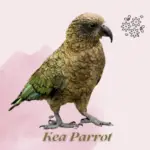
The kaka parrot or forest parrot ( Nestor meridionalis ) is, next to the kea ( Nestor notabilis ), the second extant species of Nestor’s parrot found in New Zealand. A third species, the thin-billed nester, lived north and northeast of it in the Norfolk Islands until the mid-19th century.
Systematics History
Occasionally regarded as conspecific with globally threatened N. meridionalis of New Zealand. N. norfolcensis is a synonym. Monotypic.
Subspecies
Extirpated in the mid-19th century on Norfolk I, and possibly a little later on Phillip I. The last known living individual was in captivity in London, England, in 1851.
Species said to have been very tame and easily caught, and was, therefore, an easy target for human settlers, who killed it for food; habitat clearance, too, probably played a part in its extinction.
Reproduction
The kaka is a parrot about 40 cm long. The color of the plumage is dominated by shades of brown on the nape, back, chest, and upper sides of the wings.
The belly, the underside of the wings, and a band between the neck and back are reddish, the forehead and top of the head are grey-white.
The male has a more curved beak than the female.
Distribution

norfolk island kaka
It inhabits the forests of New Zealand, in summer the heights of 450 to 850 m, in winter they occur from the flat coastal areas to the heights of 550 m, but are occasionally also observed at heights of up to 1500 m and in gardens and parks.
The subspecies N. meridionalis meridionalis occurs on the South Island and N. meridionalis septentrionalis on the North Island. Both subspecies are threatened.
It is extinct on the Chatham Islands.
Behavior
The kaka parrot lives mainly in the forest, but it also frequents bushes, parks, and gardens. He needs trees to sit on. Kakas are extremely adept climbers, although they are quite capable of hanging upside down from a branch for food, and they use their beak as a third foot.
The birds also pollinate other plants through the pollen they collect in their head feathers. Except during the breeding season, it lives together in smaller groups of up to ten specimens. Usually, this bird is active at dawn, dusk, and light nights.
Intraspecific aggressive behavior (e.g. when there is a shortage of food) is expressed in growling, screeching, and/or flapping the wings together with beak beating. Otherwise, Kaka parrot can also whistle and trill melodically; regional populations of the species also have the ability for different dialects.
Diet

Norfolk Island Kaka parrots
The kaka feeds on fruits, seeds, buds, insects, and their larvae and pupae, but also on flower nectar ( honeydew ) and shoots.
An important part of its diet is the secretions of a scale insect that lives in the bark of trees and, when rearing the young, the seeds of the southern beech. This unusual diet is a reason for the endangerment of the species, in addition to the narrowing of the habitats.
breeding cycle
Not regularly every year, but about every two to four years, the Kaka parrot mating, the subsequent laying of eggs, the 21-day brood, and subsequent rearing of the 4-5 young (of which usually only 2 survive) takes place.
At first, it was thought that this irregular breeding cycle would depend solely on the changing supply of the energy-giving honeydew.
Later, however, researchers established the primarily direct dependence on the fruit cycle of the southern beech. In the years in which these trees develop a particularly large number of seeds and therefore a large supply of food for the kakas and they’re young is guaranteed, breeding also occurs regularly.
Presumably, the birds also live predominantly monogamously outside of the breeding season. During courtship, the male displays his luminous undersides of wings, fans his tail feathers, and moves his head vertically.
The female signals her readiness to mate by sitting and turning her tail feathers to the side, whereupon the male holds on to her partner’s back with spread wings.
Cockatoos breed in tree cavities, rarely in rock crevices or a kiwi burrow. The kaka parrot will use tree cavities once chosen across multiple broods. The floor is covered with nibbled wood shavings.
The female usually incubates, only occasionally the male, who brings food to his partner during this time, takes over from him. At about 10 weeks, the young fledge and leave the nest.
Conservation Status

The explosive increase in the number of imported European wasp species (now the common wasp ), which also live on the high-energy honeydew of scale insects and insects, has reduced the kakas’ food base to such an extent that their existence is seriously endangered in the long term if this does not succeed to significantly reduce the population of common wasps.
With the introduction of the weasel, which is not originally native to New Zealand, the kaka is even more endangered, since many female kakas brooding in tree cavities regularly fall victim to these predators in a breeding cycle.
In the Eglinton Valley National Park on New Zealand’s South Island, where kaka parrot was tagged with transmitters, a 2008 study based on these data and calculations showed that kaka only had a chance of survival if the number of ermine traps remained the same as since the early 1990s is set up.
In Europe, Kakas are only kept in the Wilhelma in Stuttgart.




















